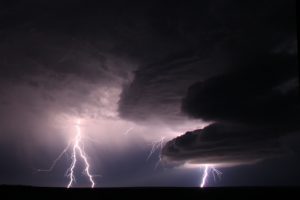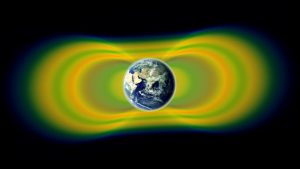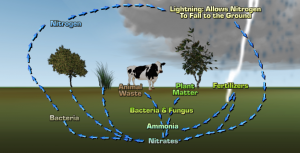
I had intended to write about the use and destruction of soil by ancient civilizations for another couple of weeks, but the stories will still be there next month; I think I’ll take a break from farming follies.
A big thunderstorm hit last night. I forgot to bring my trays of seedlings indoors and expected them to be beaten down this morning; but the tiny plants were fine. Perky. Lightening is good for them; they like it, like I like expensive cheese or fine chocolate. Can’t live on it– but it makes life better. Plants probably know electric and magnetic energy surround us and use it when they can.
Charged particles are a part of the air we breathe. We live in a gigantic magne tic field that extends from Earth’s interior into Space. This field protects us from the solar winds, cosmic rays, ultraviolet radiation and certain destruction. Beyond are the Van Allen radiation belts, pictured to the right– “giant swaths of magnetically trapped, highly energetic charged particles that surround Earth.” Getting through these belts is a big problem for NASA. http://www.space.com/33948-van-allen-radiation-belts.html.
tic field that extends from Earth’s interior into Space. This field protects us from the solar winds, cosmic rays, ultraviolet radiation and certain destruction. Beyond are the Van Allen radiation belts, pictured to the right– “giant swaths of magnetically trapped, highly energetic charged particles that surround Earth.” Getting through these belts is a big problem for NASA. http://www.space.com/33948-van-allen-radiation-belts.html.
Within our magnetic soup bowl, lightening forms. It produces hot electric charges in clouds; then Nitrogen and Oxygen come together to make nitrogen oxides that descend on their own or in raindrops. Although Nitrogen is all around us, (almost 80% of the atmosphere) plants can’t use it until lightening works its magic.
I don’t like this diagram, it makes a series of grand events look banal. But I love circles and the circle below describes Nitrogen’s trip through our soil and back to the heavens.

Gardeners are always anxious about the nitrogen in the soil. Other elements stick, but not Nitrogen. And atmospheric nitrogen fixation that occurs during thunderstorms only contributes 8% or so of Nitrogen used by our plants, but we are greedy and take what we can get. I think all these charged particles created in a rain storm have value beyond the quantification of 8%; that soil and our plants might engage in activity we don’t understand–yet. I am by no means the craziest gardener on the subject of electricity in the garden.
We are counseled to drive wooden stakes into the garden and run copper wire around them to attract static electricity. Another suggestion to attract static electricity is to use metal stakes for plants like tomatoes and to tie the plants to the stakes with pantyhose. Since pantyhose were undoubtedly developed in some dark place in the underworld, it makes me happy to picture them on a stake in the hot sun. http://www.veggiegardener.com/how-lightning-benefits-your-garden/
Like I said, gardeners take what they can get. I wrote last week about the Chinese at the turn of the 20th Century. No labor was too hard, no conservation too extreme if it improved their soil. They added their clothes to the compost pile. Considering all the work and aggravation associated with improving soil, it is a wonderful thing to sit on the porch and watch a storm. I like to watch the lightening improve my soil while gently moving my rocking chair and sipping a glass of wine.